The New England Journal of Medicine has published the results of a clinical trial with a new drug for the treatment of hepatic steatosis (fatty liver).
Fibroblast (which is a type of human cell) growth factor regulates lipid and glucose metabolism and energy expenditure. For this reason, fibroblast growth factor (FGF) may be useful in the treatment of hepatic steatosis and a drug analogous to FGF has been developed and tested in patients with fatty liver.
The study included 192 patients diagnosed with steatosis by liver biopsy who were divided into several groups to receive FGF subcutaneously for 24 weeks at a dose of 15 mg or 30 mg once a week or a dose of 44 mg every two weeks. or placebo.
Decrease in the percentage of fat in the liver
With all doses of FGF it was observed an improvement in liver fibrosis in a significant percentage of patients: 22% (15 mg), 26% (30 mg) and 27% (44 mg) versus 7% of those who received placebo. On the other hand, the percentage of patients in whom steatosis resolved was 2% in the placebo group versus 37%, 23%, and 26% in the 15 mg, 30 mg, and 44 mg group, respectively.
At least, a 50% of decrease in liver fat occurred in 63% of patients receiving 30 mg FGF and 58% in the 44 mg group vs 12% in the placebo group. Transaminases also normalized in 59% of patients treated with 30 mg and in 65% of those who received 44 mg versus 24% of the placebo group. In addition, a significant decrease in triglycerides was detected with an increase in HDL cholesterol (good cholesterol) in patients treated with FGF.
There are still more rehearsals to perform
Side effects (nausea, dyspnea, and redness at the injection site) occurred in 95% of those treated with 15 mg and in 85% and 67% of those treated with 30 and 44 mg respectively, compared to 68% of those of the placebo group.
In summary, results of this clinical trial with the FGF analogue drug are promising but more studies with a larger number of patients are needed for its approval as a treatment for fatty liver. In the opinion of Dr. Carreño’s group, it could also be useful in cardiovascular problems since it increases the levels of good cholesterol or HDL, although this would have to be confirmed with specific clinical trials.




